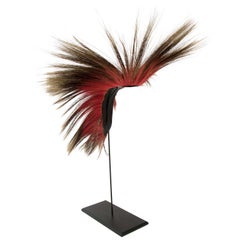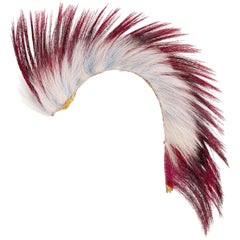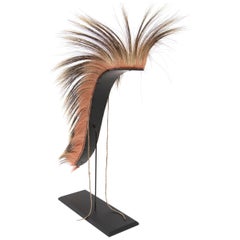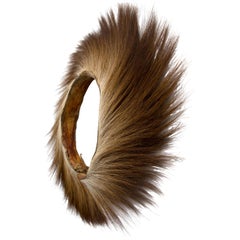Native American Roach
Antique 19th Century American Native American Native American Objects
Fur
Antique 1880s American Native American Native American Objects
Fur
Early 20th Century American Native American Native American Objects
Other
Recent Sales
Antique 19th Century American Native American Native American Objects
Animal Skin
Antique 19th Century American Native American Native American Objects
Hide
Antique Late 19th Century American Native American Native American Objects
Antique Early 19th Century American Native American Objects
Antique 19th Century American Native American Native American Objects
Antique 19th Century American Native American Objects
Leather
People Also Browsed
Antique 1870s American Native American Native American Objects
Hide
20th Century North American Native American Native American Objects
Wool
Antique Late 19th Century European Moorish Architectural Elements
Wrought Iron
Antique 19th Century Italian Desks and Writing Tables
Mahogany
Mid-20th Century English Renaissance Beds and Bed Frames
Oak
Vintage 1920s American Native American Decorative Baskets
Willow
20th Century American Native American Native American Objects
Natural Fiber
Antique 19th Century Balkan Islamic Arms, Armor and Weapons
Gold, Silver, Steel
Antique Mid-19th Century French Arms, Armor and Weapons
Steel
Early 20th Century Native American Objects
Bakelite, Beads
Mid-20th Century American Native American Native American Objects
Other
Mid-20th Century American Navajo Native American Objects
Sterling Silver
Antique 19th Century Italian Victorian Wardrobes and Armoires
Walnut
Mid-20th Century American Native American Native American Objects
Pottery
Early 20th Century American Native American Native American Objects
Hide, Beads
Vintage 1930s Canadian Native American Native American Objects
Wood
A Close Look at Native-american Furniture
Native American broadly describes any Indigenous people in North America and encompasses hundreds of tribes and groups, all with distinct cultures. Native American–style furniture and decor likewise varies widely, from pieces created by Indigenous people to those appropriated by non-native designers.
Indigenous furniture’s rich heritage includes the bentwood boxes of the Northwest Coast carved from cedar for storing household or ceremonial objects. Generations of Native American people have made baskets for holding household items, with those in the Northeast using sweetgrass and those in the Southeast using pine needles and wicker. Artisans in the Plateau region wove watertight pieces like cradles from plant materials. Although these objects were intricately made, they were usually utilitarian rather than decorative.
The colonization of North America and the removal of Indigenous people from their lands led to the suppression of these practices. Many styles that used Native American motifs — such as Southwestern style, which was heavily influenced by the geometric patterns of Navajo textiles — have historically not involved Indigenous creators and, instead, have taken their traditions without their tribal context.
When decorating a home with Native American–style furniture, it is important to do so respectfully, by understanding the origins of motifs and objects and examining who profits from their sale. There are now Indigenous-led companies, such as Cherokee designer Cray Bauxmont-Flynn’s Amatoya and Totem House Design, promoting Indigenous work in furniture and home decor. Supporting Indigenous artists and artisans is essential to confronting the still pervasive issue of cultural appropriation in design.
Find a collection of Native American living room furniture, folk art, rugs and carpets, decorative objects and other items on 1stDibs.
Finding the Right Native-american-objects for You
As part of thoughtful home decor, antique and vintage Native American objects — works created by Native American artists and artisans — can bring rich textures and colors into a space.
Art collecting can be done in a socially and environmentally conscious way that reinvests in local communities. Tribal art is traditionally crafted with earth-friendly materials that respect the environment.
Textiles have long been objects of art and utility for Native Americans. Traditional weaving techniques involve material made from plant and animal fibers. Different tribes have woven distinctive patterns and colors into blankets, rugs and garments, such as the vibrant geometric shapes woven from wool by the Navajo.
After metal and glass beads were introduced to North America by Europeans, they became a popular form of art. Intricate beading appears on clothing, jewelry and other objects. Beadwork not only looks stunning, but it is also deeply emblematic of Native American ethnicity and can be used to pass stories handed down from generation to generation. Beaded garments have often been commissioned for important events like weddings, dances and celebrations.
Native Americans initially created pottery out of necessity to carry water and store food. For centuries, artists have decorated jugs, vases and other vessels, from designs etched into clay to experimentation with firing methods for unique finishes.
Find a diverse collection of colorful and culturally enriching antique and vintage Native American decorative items, objects and much more on 1stDibs.
- 1stDibs ExpertOctober 12, 2021A Native American artifact is any object that provides insight into the lives and history of native people in America. These items range from carved stone pipes, weapons for hunting, tools for cooking, pottery, jewelry and more. Find a collection of artifacts on 1stDibs today.
- 1stDibs ExpertApril 5, 2022In the Native American language of Powhatan spoken by the Algonquian indigenous people, moccasin refers to a hand-sewn suede bootie. Today, people may call any shoes that feature stitched round toes by the name. Shop a variety of moccasins on 1stDibs.
- 1stDibs ExpertApril 5, 2022There are a wide array of different dolls made by the various tribes of Native American peoples. Some of the most well-known are the kachinas made by the Navajo, Hopi and Pueblo peoples. Shop an array of Native American dolls on 1stDibs.
- 1stDibs ExpertApril 5, 2022What Native Americans used to produce baskets varied from tribe to tribe. Generally, craftsmen used whatever materials were readily available. In the Northeast, sweet grass was a common material, while pine needles and wicker are frequently found in baskets produced by tribes in the Southeast. Find a range of vintage and antique baskets on 1stDibs.
- 1stDibs ExpertApril 5, 2022To identify Native American baskets, you can research the patterns using authoritative online resources to try and determine which tribe produced it. However, many replicas exist and there are many tribes that produced baskets. As a result, it is a good idea to consult a licensed appraiser. On 1stDibs, find a variety of expertly vetted Native American baskets.
- 1stDibs ExpertApril 5, 2022What Native American drums are called varies by type. Ones designed to rest in the player's lap are hand drums, while instruments that hold water used primarily by the Iroquois and Yaqui are water drums. Large freestanding drums that produce loud percussive sounds are powwow drums. The Aztec and Hopi used foot drums. You'll find a range of Native American drums on 1stDibs.
- 1stDibs ExpertApril 5, 2022Native American slippers are called moccasins. Moccasins are characterized by their U-shaped puckered toe design and are crafted with various leathers such as sheepskin or buffalo. They may or may not be decorated with beading. Shop a collection of authentic moccasins from some of the world’s top sellers on 1stDibs.
- 1stDibs ExpertApril 5, 2022It depends on which region the beads were made since they were created out of available materials found in the land around them. In the Eastern Woodlands, white and purple marine shell beads were called “wampum”. You can shop a collection of Native American beadwork from some of the world’s top boutiques on 1stDibs.
- 1stDibs ExpertApril 5, 2022The most well-known Native American blankets come from Navajo weaving, which are prized by collectors worldwide. Originally utilitarian, the Navajo people began creating blankets specifically for export and tourism in the 19th century. Shop a collection of Navajo blankets from some of the world’s top sellers on 1stDibs.
- 1stDibs ExpertApril 5, 2022What a Native American headdress represents depends on what tribe produced it. In general, headdresses may symbolize a person's status within the tribe or serve as a sign of bravery during battle. You'll find a selection of Native American headdresses on 1stDibs.
- 1stDibs ExpertNovember 13, 2024To identify Native American beadwork, first consider the materials. Indigenous American artisans often produce beads out of glass and natural materials, such as shells, bone and wood, and use metal and plastic in their pieces less frequently. Older pieces will usually be held together by sinew, while newer examples will typically feature thread. Regardless of age, Native American beadwork will typically be expertly crafted, so pieces usually have tight, even stitching with no visible gaps. Familiarizing yourself with stitching techniques used by various tribes can also be helpful. You can find images of authentic beadwork on trusted online resources to refer to as you complete the identification process. Alternatively, you can have a certified appraiser or experienced antique dealer evaluate your piece. On 1stDibs, shop a wide variety of textiles and garments that feature Native American beadwork.
- 1stDibs ExpertApril 5, 2022What rattles symbolize in Native American culture varies from tribe to tribe. Some indigenous people believe they serve as connections between the natural and spiritual worlds. Others believe they represent the ties between animals, plants and minerals. In addition, rattles sometimes symbolize independence. On 1stDibs, find a selection of Native American rattles.
- 1stDibs ExpertOctober 30, 2024Yes, some Native American jewelry is worth something. As with other types of jewelry, many pieces are made of fine materials, such as sterling silver, turquoise, jasper and lapis lazuli. Jewelry produced by Native American artists may also have value based on its age, style, type and other factors. Find a large selection of Native American jewelry on 1stDibs.
- 1stDibs ExpertApril 5, 2022To tell if Native American jewelry is real, have it evaluated by a licensed and experienced appraiser. Because every tribe has its own designs and identifying characteristics, it is usually not possible to determine authenticity using only online resources. Find a collection of expertly vetted Native American jewelry on 1stDibs.
- 1stDibs ExpertMay 5, 2023A number of Native American tribes are known for pottery, including the Cheyenne, Cherokees, Hopi, Iroquois, Navajo Pueblo and Shoshone. Artisans from each indigenous group have their own style. For example, Hopi pottery is often a red-brown color and decorated with black designs, while Navajo pottery is deeper brown and usually has a high-gloss finish. Find a selection of Native American pottery on 1stDibs.
- 1stDibs ExpertApril 5, 2022The two types of Native American beadwork are called the “lazy stitch” or “lane stitch” and the “tack stitch” or “flat stitch”. You can shop a collection of Native American beadwork from some of the world’s top boutiques on 1stDibs.




